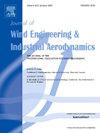基于机器学习的城市风激压电能量采集器性能预测
IF 4.9
2区 工程技术
Q1 ENGINEERING, CIVIL
Journal of Wind Engineering and Industrial Aerodynamics
Pub Date : 2025-09-16
DOI:10.1016/j.jweia.2025.106222
引用次数: 0
摘要
缓解气候变化的紧迫性日益增加,这引起了人们对可再生能源解决方案的极大兴趣,包括从压电材料的风力振动中收集能量。虽然大多数先前的研究都是通过可控风洞实验和计算流体动力学(CFD)模拟来优化能量采集器的设计,但它们在现实世界的长期条件下的性能仍未得到充分的探索。本研究通过在城市环境中部署压电能量采集器,并使用一个月的环境风数据分析其性能,解决了这一差距。机器学习(ML)模型的开发是为了根据风速、方位角和仰角以及日/夜变化来预测收割机的输出电压。结果表明,风速大小影响电压输出,对方向和高程分量有明显的敏感性,这与城市环境有关,在城市环境中,风与周围结构相互作用。在测试的ML模型中,随机森林(RF)表现出最高的预测精度,优于梯度增强回归树(GBRT)和决策树回归(DTR)。这项工作强调了机器学习驱动方法的潜力,可以提高部署在复杂城市环境中的压电风激能量收集器的运行效率。本文章由计算机程序翻译,如有差异,请以英文原文为准。
Machine Learning-based prediction of the performance of a wind-excited piezoelectric energy harvester deployed in urban environment
The growing urgency to mitigate climate change has driven significant interest in renewable energy solutions, including energy harvesting from wind-induced vibrations from piezoelectric materials. While most prior research has optimized energy harvester designs through controlled wind tunnel experiments and computational fluid dynamics (CFD) simulations, their performance under real-world, long-term conditions remains largely unexplored. This study addresses this gap by deploying a piezoelectric energy harvester in an urban environment and analysing its performance using one month of ambient wind data. Machine learning (ML) models are developed to predict the output voltage of the harvester based on wind speed, azimuth, and elevation angles, as well as diurnal/nocturnal variations. The results revealed that wind speed magnitude influences voltage output, with clear sensitivity to directional and elevation components, which is of relevance in urban environments, where wind interacts with the surrounding structures. Among the tested ML models, Random Forest (RF) demonstrated the highest predictive accuracy, outperforming Gradient Boosting Regression Trees (GBRT) and Decision Tree Regression (DTR). This work underscores the potential of ML-driven approaches to improve the operational efficiency of piezoelectric wind-excited energy harvesters deployed in complex urban environments.
求助全文
通过发布文献求助,成功后即可免费获取论文全文。
去求助
来源期刊
CiteScore
8.90
自引率
22.90%
发文量
306
审稿时长
4.4 months
期刊介绍:
The objective of the journal is to provide a means for the publication and interchange of information, on an international basis, on all those aspects of wind engineering that are included in the activities of the International Association for Wind Engineering http://www.iawe.org/. These are: social and economic impact of wind effects; wind characteristics and structure, local wind environments, wind loads and structural response, diffusion, pollutant dispersion and matter transport, wind effects on building heat loss and ventilation, wind effects on transport systems, aerodynamic aspects of wind energy generation, and codification of wind effects.
Papers on these subjects describing full-scale measurements, wind-tunnel simulation studies, computational or theoretical methods are published, as well as papers dealing with the development of techniques and apparatus for wind engineering experiments.

 求助内容:
求助内容: 应助结果提醒方式:
应助结果提醒方式:


